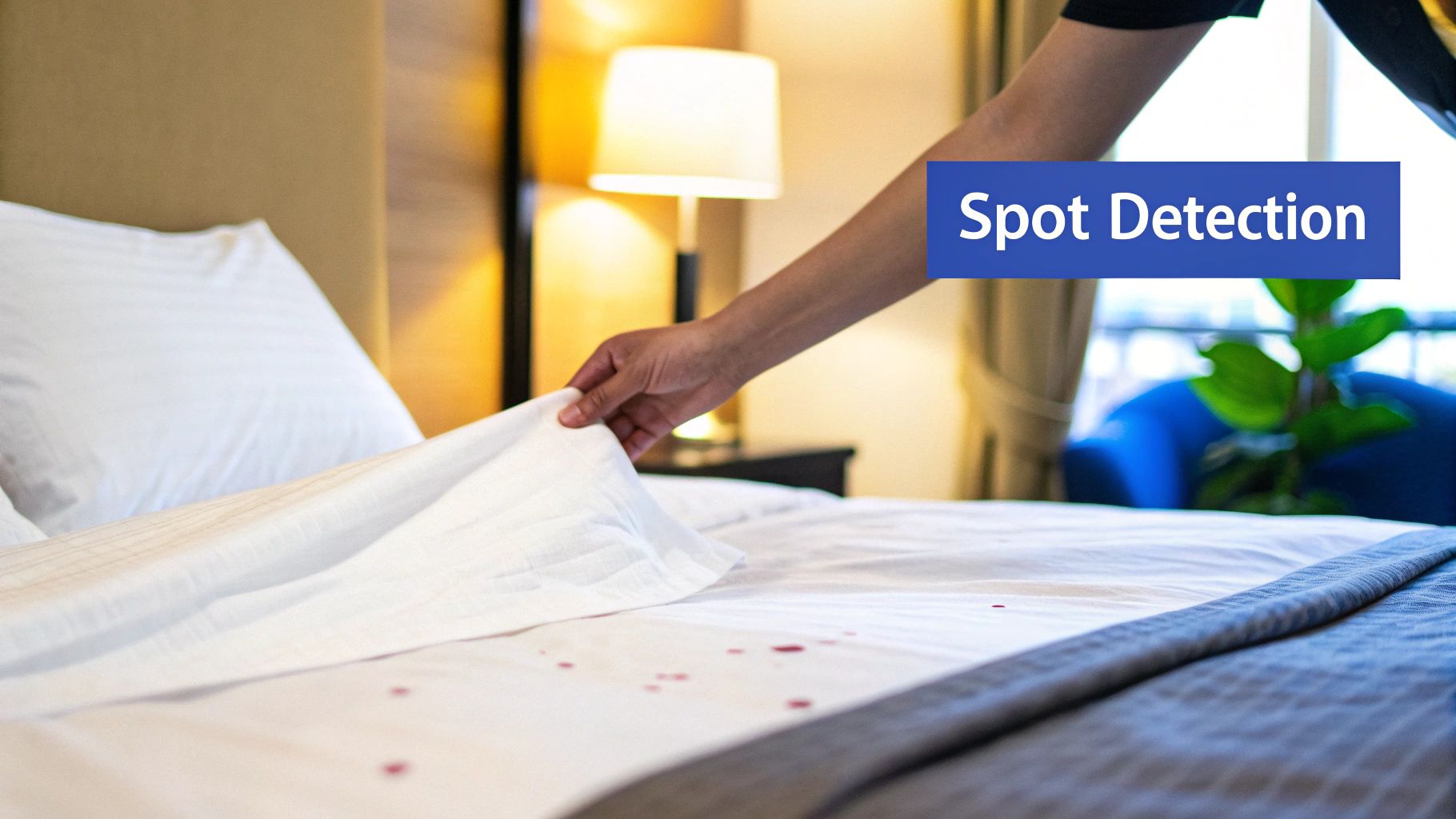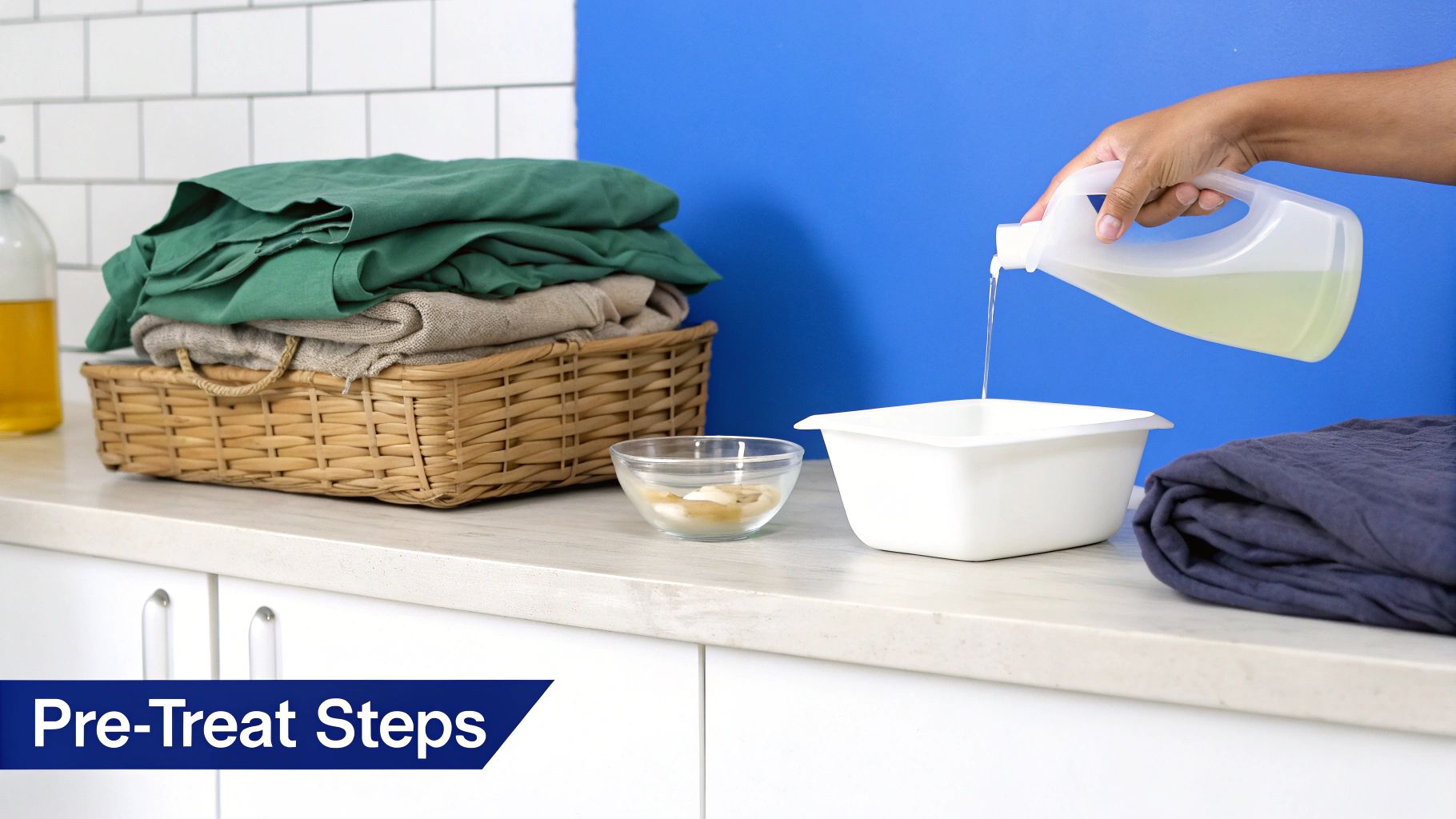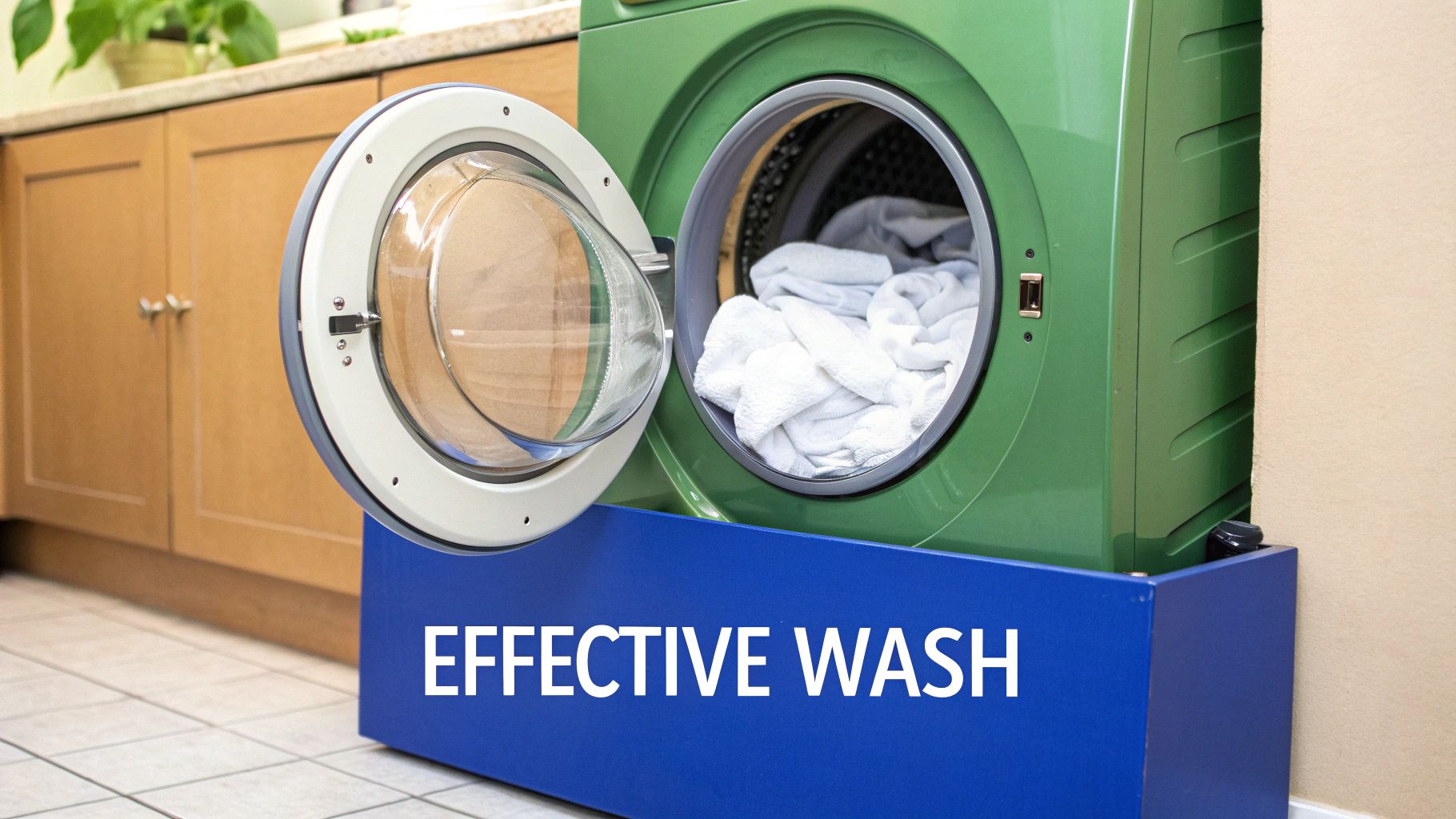When it comes to getting urine smell out of your bedding, the clock is ticking. You need to strip the bed immediately, pre-treat the stain with something that neutralizes the odor (like vinegar or an enzymatic cleaner), and then wash everything in the hottest water the fabric can handle. Moving fast is absolutely crucial to stop the uric acid from permanently bonding with the fibers.
Your First Moves Against Urine Odor in Bedding
Discovering a urine accident on the bedding is always frustrating, but how you react in those first few minutes makes all the difference. It's the difference between a simple laundry job and a smell that just won't quit.
Time is your biggest enemy here. The longer urine sits, the more its uric acid crystals latch onto fabric fibers, which is what makes that odor so incredibly stubborn.
Your first step, without a doubt, is to strip the bed completely. Get all the soiled items—sheets, blankets, mattress protectors—and keep them separate from your other laundry. This prevents the odor from spreading. Whatever you do, don't just toss them in the hamper to deal with later.
Choosing Your Initial Treatment
With the bedding off the bed, it's time for a pre-treatment. You generally have two paths you can take: common household remedies or specialized enzymatic cleaners.
- Household Solutions: Things like distilled white vinegar and baking soda are fantastic for fresh accidents. They're cheap, you probably already have them, and they do a great job neutralizing the ammonia that causes that sharp, unpleasant smell.
- Enzymatic Cleaners: These are the heavy hitters. They’re specifically designed with enzymes that literally break down and consume the organic proteins in urine. If you're dealing with an older, set-in stain or a particularly strong odor (pet parents know what I'm talking about), this is the way to go.

When you're deciding what to grab first, it helps to weigh the pros and cons of each approach.
Comparing Initial Treatment Options for Urine Odor
| Treatment Method | Best For | Pros | Cons |
|---|---|---|---|
| White Vinegar & Water | Fresh, wet stains. | Inexpensive, readily available, effective ammonia neutralizer. | Strong initial vinegar smell (dissipates when dry). |
| Baking Soda | Fresh stains, absorbing moisture. | Excellent at absorbing liquid and odor, very gentle on fabrics. | Can be messy, less effective on its own for set-in odors. |
| Enzymatic Cleaners | Old, set-in stains; strong pet or human urine odors. | Highly effective at breaking down the source of the odor. | More expensive, requires a specific purchase. |
| Just Water Rinse | Immediate, minor spills. | Better than nothing, helps dilute the urine. | Won't neutralize uric acid or eliminate deep-set odors. |
Ultimately, while household items are great in a pinch, enzymatic cleaners are engineered for this exact problem and deliver the most reliable results, especially for tough jobs.
A great first step many people swear by is applying a mix of distilled white vinegar and water. It directly neutralizes the ammonia. Yes, it has a strong scent at first, but that smell completely disappears as the fabric dries—and it takes the urine smell with it.
This initial attack on the stain is crucial, especially for those providing in-home care. For more on that topic, you can find helpful information in our guide on caregiving.
Pre-Treating Stains Before They Set

It’s tempting to just throw urine-soaked bedding straight into the washing machine, but this is a classic mistake that will almost always lock in the smell. The real secret to getting that stubborn odor out for good is all in the pre-treatment. You have to break down the smelly compounds before they ever hit the main wash cycle.
The good news is you don’t need a cabinet full of expensive cleaners to do this. A couple of everyday household items can make a world of difference. Your main goal here is to neutralize the uric acid, which is the true source of that sharp, lingering odor. If you skip this, you’re just washing away the liquid and leaving the stinky crystals behind.
The Vinegar Solution for Ammonia Breakdown
Distilled white vinegar is your best friend here. Its natural acidity is the perfect weapon against the ammonia in urine. This simple chemical reaction doesn't just mask the smell—it neutralizes it at the source.
Just mix equal parts distilled white vinegar and cool water in a spray bottle. Get in there and really spray the affected area until the fabric is completely saturated. Don't be shy with it. And don’t worry about the vinegar smell; I promise it vanishes completely once the bedding is dry.
Let that solution soak in for at least 15-20 minutes. This is non-negotiable. You need to give the vinegar enough time to work its way into the fibers and really break down those uric acid crystals.
Key Takeaway: The power of white vinegar comes from its acidity. It chemically neutralizes the alkaline ammonia, which is what causes that unpleasant, sharp urine smell.
Using Baking Soda to Absorb and Deodorize
Once the vinegar has had time to do its job, it’s time for part two: baking soda. This is your go-to for soaking up any leftover moisture and tackling any faint, lingering odors. Baking soda is a fantastic natural absorbent and deodorizer.
You can go about this in two ways:
- Sprinkle It On: For a fresh, wet spot, just sprinkle a generous amount of dry baking soda right over the vinegar-treated area. You'll see it start to work immediately, absorbing the moisture and neutralizing the smell.
- Make a Paste: If you're dealing with a more concentrated stain, mixing baking soda with a little water to form a thick paste gives you a more targeted attack. Just spread the paste right onto the stain.
Whichever method you choose, let the baking soda sit until it's totally dry, which might take a few hours. As it dries, it pulls the moisture and odor molecules right out of the fabric. Once it’s dry and caked, just scrape or vacuum off the excess before you toss the bedding in the wash.
Mastering this pre-treatment is a vital skill, especially for those in caregiving roles. For a closer look at other caregiving resources, you might find our in-home care services guide helpful.
Your Washing Machine Protocol for Odor Elimination

After you've pre-treated the bedding, it's time for the washing machine to do the heavy lifting. But just tossing it in with a scoop of detergent won't cut it. To truly knock out that stubborn urine smell, you need a specific game plan that targets the odor-causing bacteria.
The first, and maybe most important, step is to use the right water temperature. Always wash the bedding in the hottest water the fabric can safely handle. Go ahead and check the care label, but most cotton and linen sheets can take the heat. A hot cycle is a game-changer for sanitizing and killing off any bacteria that survived the pre-treatment.
Supercharge Your Detergent
Even a great detergent needs some backup when you're fighting a smell this persistent. A couple of simple, everyday household items can give your wash cycle the boost it needs to neutralize any lingering uric acid.
- White Vinegar: Pour one cup of distilled white vinegar right into the fabric softener dispenser. It gets released during the rinse cycle, where it neutralizes odors without making your bedding smell like a salad.
- Baking Soda: Add a half-cup of baking soda directly into the drum with your bedding. It’s a natural deodorizer and has the added bonus of softening the fabric.
Pro Tip: Whatever you do, never mix vinegar and bleach. This combination creates dangerous chlorine gas. If you need a whitener, stick with an oxygen-based bleach. It’s much safer and won't ruin your colored fabrics.
If you're dealing with a really tough case, it might be time to bring in the big guns: a specialized enzymatic cleaner. These cleaners are specifically designed to break down organic matter—like urine—at a molecular level.
The enzymes literally "eat" the proteins that cause the smell, which is far more effective than just masking it. You can usually add the enzymatic cleaner right into the wash along with your regular detergent. For getting that urine smell out of bedding for good, this is your best shot.
Tackling Old and Stubborn Urine Smells

Sometimes you find a urine stain long after it has dried and settled deep into the fabric. These kinds of stubborn situations demand a more aggressive approach than just tossing the bedding in the wash. When you're dealing with an old, concentrated odor, you need something that can break down the uric acid crystals on a chemical level.
A surprisingly effective solution for these tough jobs is a simple mix of hydrogen peroxide, baking soda, and a little dish soap. This combination creates a powerful, oxygenated cleaner that works wonders on set-in stains. The chemistry behind it is straightforward but effective: the peroxide lifts the stain, acting as a gentle bleach, while the baking soda gets to work absorbing those deeply embedded odors.
How to Create and Apply the Solution Safely
To mix up this powerful cleaner, you just need a spray bottle and a few things you probably already have. This formula is especially useful for those frustrating smells on bedding or mattresses that haven't responded to anything else.
A 2025 article from the Sleep Foundation highlights how hydrogen peroxide's natural bleaching properties can break down dried urine stains that regular detergents often can't touch. Their recommended formula is one cup of hydrogen peroxide, three tablespoons of baking soda, and a few drops of liquid dish soap. Gently swirl this mixture in a spray bottle to combine everything—avoid shaking it. You can learn more about this method for removing urine stains from mattresses in their detailed guide.
Crucial Precaution: Hydrogen peroxide can have a mild bleaching effect. Before you go all-in on your bedding, always test the solution on a small, hidden spot to make sure it doesn't cause any discoloration, especially on colored fabrics.
Once you’ve done a spot test, spray the solution generously over the entire stained area until it's thoroughly damp. Now, just let it sit and air dry completely. As it dries, you’ll notice a baking soda residue forming, which you can simply vacuum up. This process is a game-changer for anyone trying to figure out how to get urine smell out of bedding for good.
Dealing with these challenges is a common part of providing care. You can find more practical information in our NJ Caregiving resources.
Let's be honest, dealing with urine odors is a pain. The best strategy is to stop the accident from ever reaching your mattress in the first place.
Your first line of defense, and frankly the most effective one, is a high-quality waterproof mattress protector. This simple layer is an absolute game-changer because it stops any liquid from soaking into your mattress—which is by far the hardest and most expensive part to clean.
Don't worry, we're not talking about those crinkly, plastic-like vinyl covers from back in the day. Today’s protectors are made with amazing breathable materials that let air circulate, so you stay comfortable and cool while getting a completely waterproof barrier.
Add a Secondary Layer of Protection
For that extra peace of mind, especially if you're in the midst of potty-training a toddler or helping an adult manage incontinence, absorbent underpads are invaluable. You can place these directly on top of the fitted sheet to catch any leaks before they have a chance to spread.
You'll generally find two types:
- Disposable underpads: Sometimes called Chux, these are perfect when you just want a quick, hassle-free cleanup.
- Washable underpads: A more eco-friendly choice, you can simply toss these in the wash with the rest of the bedding.
For the estimated 25 million adults in the U.S. affected by incontinence, using underpads is a key part of a simplified hygiene routine. It creates a physical barrier that keeps urine off the sheets entirely, which is crucial for preventing odors before they can even start. You can learn more about effective urine odor control strategies from the experts in the field.
Common Questions About Urine Odor Removal
Even with the best game plan, you can still hit a few snags trying to get that stubborn urine smell out of bedding. Let's walk through some of the questions I hear most often.
Can I Just Use Bleach on White Bedding?
It's so tempting, right? You see a stain on white sheets, and your first thought is to reach for the bleach. But for this particular problem, it's not your best move.
While bleach is fantastic for disinfecting and whitening, it doesn't actually break down the uric acid crystals—and those crystals are the real source of the lingering urine smell. You might end up with sparkling white sheets that, unfortunately, still have that faint, unpleasant odor. To truly eliminate the smell, you'll have much better luck with white vinegar or a good enzymatic cleaner. They're designed to dismantle the compounds causing the odor in the first place.
What if the Smell Is Still There After Washing?
First, don't panic. This happens more often than you'd think, and it's completely fixable. If you can still smell a trace of urine after the first wash, it just means some of that uric acid is still hanging around. The most important thing is to avoid putting the bedding in the dryer. The heat will bake in the odor, making it almost impossible to remove.
Instead, just run it through another wash cycle. This time, give it a pre-soak to really target the problem.
A second-pass treatment that works wonders is soaking the bedding for at least one to two hours in a mix of one part white vinegar to four parts cold water. After that, wash it again with an enzymatic detergent, using the hottest water the fabric can safely handle.
Are These Methods Safe for All Fabrics and Items?
This is a great question. While vinegar and baking soda are perfectly safe for sturdy fabrics like cotton and linen, you'll want to be much more careful with delicate materials or specialty items.
- Silk or Wool: Steer clear of hot water and harsh cleaners. Your best bet is a gentle, cold-water pre-soak using a mild enzymatic cleaner made specifically for delicates.
- Memory Foam: Whatever you do, never saturate a memory foam pillow or mattress topper. The key here is to spot-treat. Gently blot the area with a cloth dampened with a mild detergent solution. Then, sprinkle a generous layer of baking soda over it, let it sit for several hours to absorb the odor, and vacuum it up thoroughly.
At NJ Caregiving, we understand that managing laundry and keeping a home clean and comfortable is a vital part of well-being. If you or someone you love could use a hand with daily household tasks and personal care, our compassionate team is ready to help. Learn more about our in-home care services.



